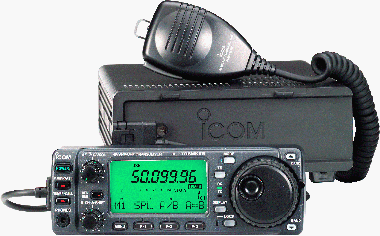IC706 vs DX70 - Good HF performance?
Serious contesters and DXers will often spend thousands of pounds on top
notch radios such as the FT1000, IC775 etc. and you will not find multibanders in use on
HF in their shacks! However the casual HF DXer or newcomer to these bands will be unlikely
to spend such a large amount of cash and to these people a multibander may provide more
appeal. People such as these may not be so discerning when it comes to HF receiver
performance or may simply not be aware of the differences between multibanders and
dedicated HF rigs, indeed I once had a newcomer to HF tell me that his FT847 had a much
better receiver than his FT990!
There have been some reviews of multiband radios and one that caught my
eye in particular was a comparison of three mini mobiles; the FT100, IC706MK2G and the
Alinco DX70. The conclusion given was that there was very little difference in HF receiver
performance between the three. The Alinco DX70 while being fairly cheap, has a much
underrated HF receiver, capable of outstanding performance comparable with rigs costing
much more. I recently acquired an IC706MK2G which I have been able to compare with my
Alinco DX70TH. So, do the lab results match the on-air tests? Read on and find out!

The Icom 706 Mark 2G
The radio itself is of sound construction with a well laid out front
panel. I found the VFO knob particularly smooth and easy to use. The radio has numerous
functions and menus, which can make operation difficult if the manual is not read
thoroughly.
I was surprised at the amount of heat generated by the transceiver even in
receive mode. The ambient receive temperature is much higher than any other radio
I’ve seen. On transmit too, a large amount of heat is generated, and whilst some of
this is dissipated, the ambient temperature of the radio seems to be permanently raised
until switch off.
Receiver performance on 2m and 70cm is fair although there is some
breakthrough from local pagers when the preamp is switched on. The signal meter response
seems to vary from excellent on HF (SSB) to fairly poor on 2m (SSB). Indeed my FT290 MK1
(known for poor signal meter response!) generally gave better reports on 2m SSB than the
IC706MK2G, although the sensitivity was clearly not as good as the Icom (I could hear
signals on the Icom that the 290 failed to register!). I have noticed the occasional
breakthrough from pagers on the Icom when on 10meters even with preamp switched off. The
audio quality on receive is somewhat 'tinny' i.e. lacking in low frequency response.
Six meter performance is comparable to the Alinco.
HF performance on the higher bands (20meters up) seemed to be comparable
with the Alinco and there was little difference between the two, with very weak signals
being picked out by both (preamp switched on). The Icom signal meter is a little more
generous than the Alinco., usually being a couple of s points up. As already pointed out,
there did seem to be the odd problem of VHF pager breakthrough on HF. This problem
has been noted on the early IC746, and was apparently due to impaired isolation between
the two antenna sockets (it does not occur unless a VHF antenna is connected to the
VHF/UHF antenna socket). I understand that the problem was corrected by Icom, so you may
not see this on later 706/746 models ( Icom 746 review in RSGB Radcom magazine March
1998).
The low band performance of the Icom was considerably below that of the
Alinco. I tuned up on 40metres in the American phone section of the band after their
sunset. I found a couple of ham stations sandwiched between hi-powered broadcast stations.
The Icom had extreme difficulty picking them out. Even with 20db of attenuation, the
American stations were masked by intermodulation and splatter. Within the European
allocation on 40meters I could always find intermodulation which made weak signal
reception very difficult. Of course this is the price that must be paid for a wide band
receiver!
I would conclude that the Icom is not really a rig that feels at home on
the lower bands (particularly 40m).
CW operation on HF definitely requires the addition of the optional
filter. Even on the higher bands the bandwidth is too wide, and you will often hear 3 or 4
signals coming through at the same time!
TX power output is a little poor on SSB on all bands, and you can’t
get anything like maximum talk power even with the mike gain turned full up and the speech
processor switched on
(see menu for details on increasing talk power). The Alinco DX70 is
covered on the next page.
|